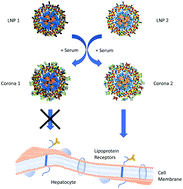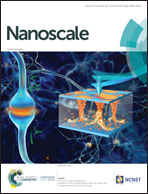The role of surface chemistry in serum protein corona-mediated cellular delivery and gene silencing with lipid nanoparticles†
Abstract
Delivery of genetic medicines, such as small interfering RNA (siRNA), by lipid nanoparticles (LNPs) is a promising approach towards the treatment of diseases, such as solid tumors. However, in vitro and in vivo nanoparticle delivery efficiency is influenced by the formation of a protein corona in biological media. In this study, we have formulated four types of EnCore nanoparticles (F1 to F4) with a similar composition, but different polyethylene glycol (PEG) conjugated lipid chain lengths (carbon 14 vs. carbon 18) and molar ratios (6% vs. 3%). These LNPs showed dramatic differences in cellular delivery and transfection in hepatocellular carcinoma (HepG2) cells in the absence and presence of fetal bovine serum (FBS). The presence of proteins inhibited the cellular uptake of C18 (3%) nanoparticles, while it facilitated the cellular uptake of C14 nanoparticles. Among the adsorbed proteins from FBS, apolipoprotein E, but not apolipoprotein A1, affected the cellular uptake of the carbon 14 LNPs. Additionally, surface PEG was one of the determinants for the protein corona amount and composition. Finally, different serum to LNP volume ratios resulted in different protein enrichment patterns. Overall, the results showed a correlation between surface chemistry of LNPs and the protein corona composition suggesting a potential use for targeted delivery.



 Please wait while we load your content...
Please wait while we load your content...